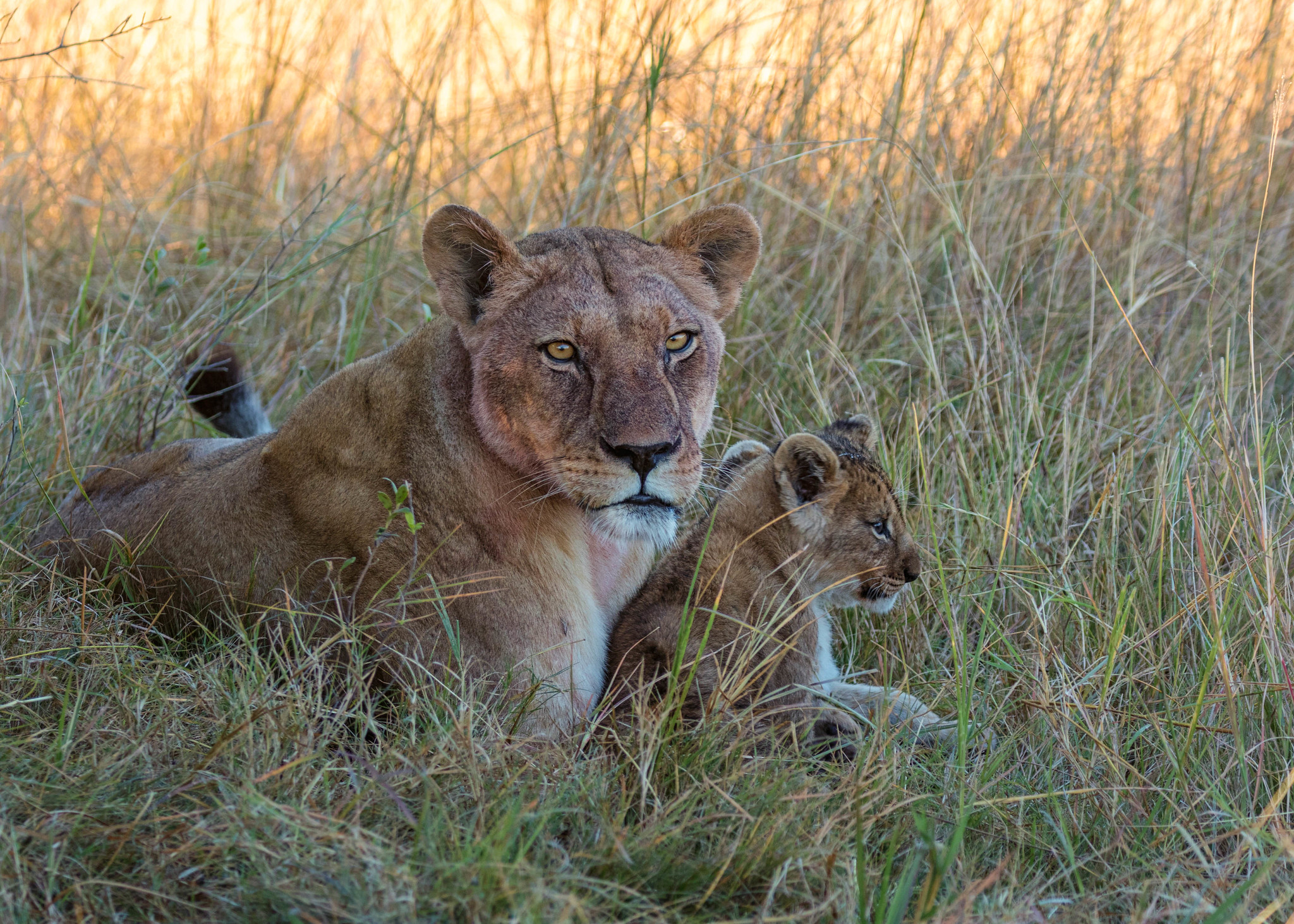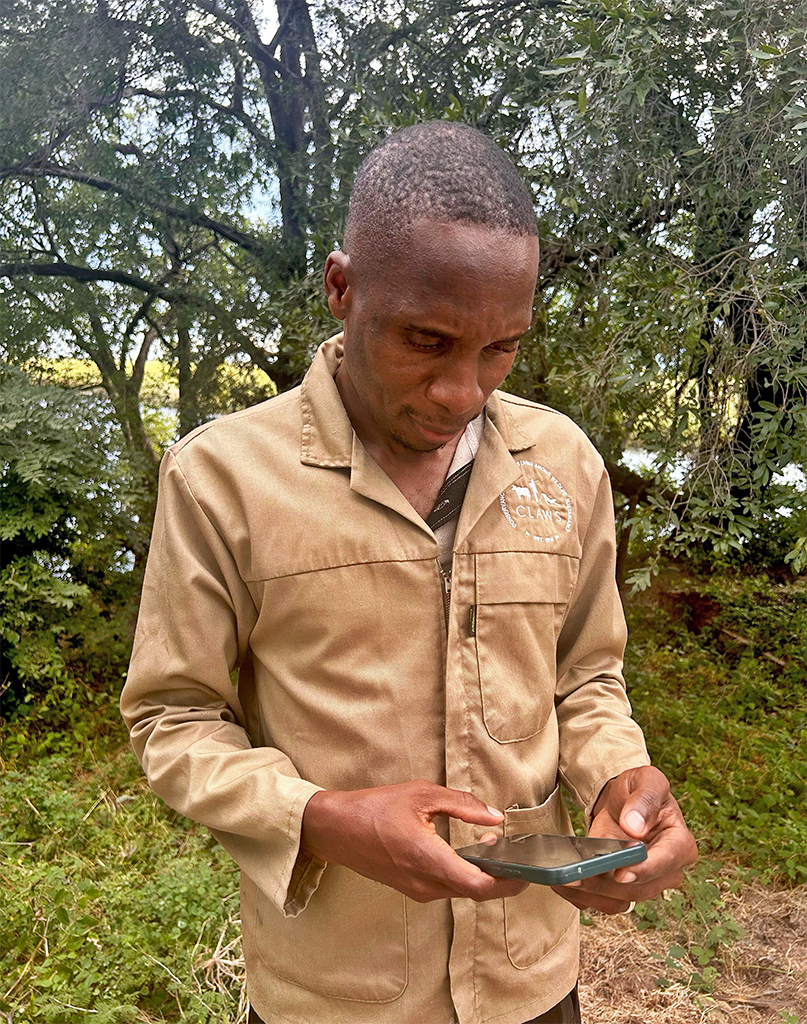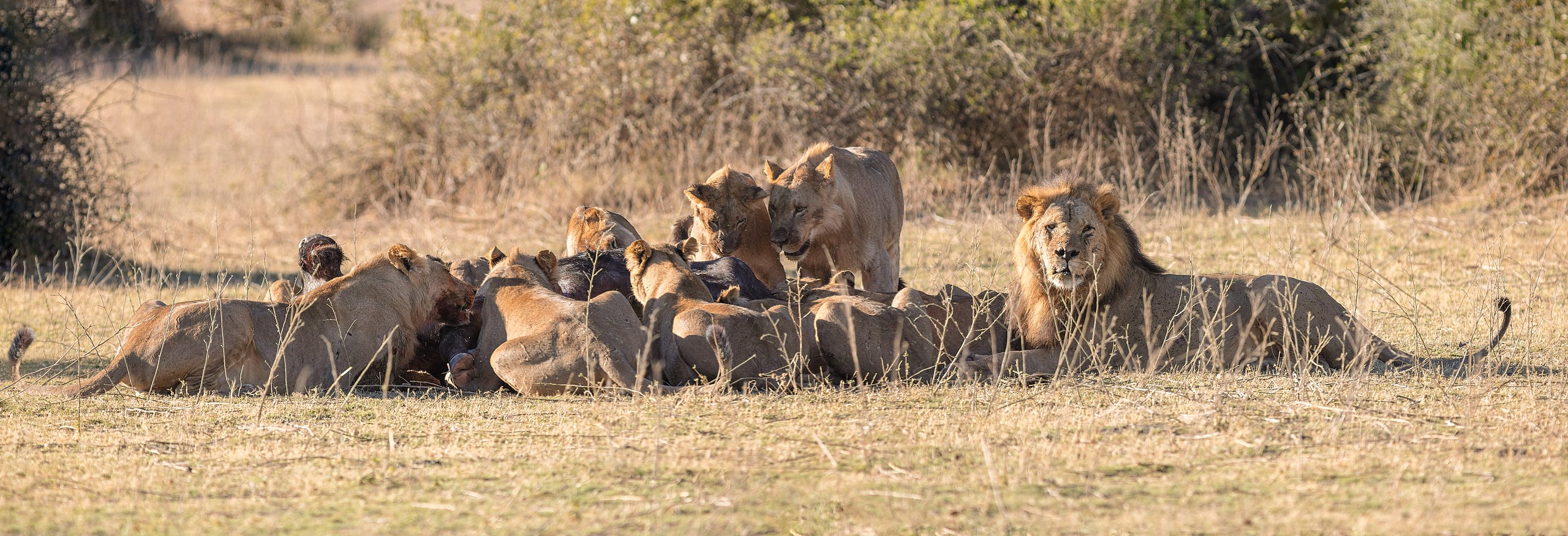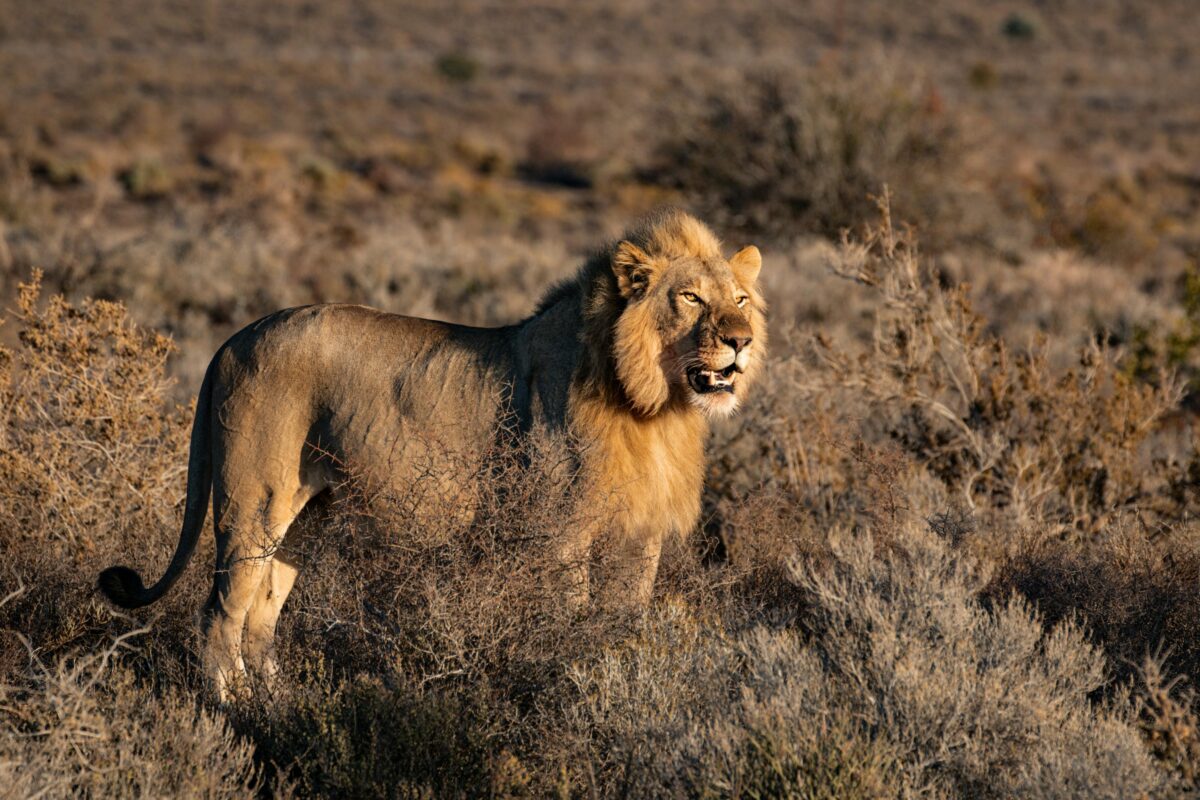- An automated, real-time alert system is helping local communities in Botswana protect their cattle from approaching lions.
- A team at the nonprofit Claws Conservancy is also working with communities to name individual lions in order to help them build a connection with the animals.
- The initiative was launched to mitigate human-lion conflict, which often led to loss of livestock and the retaliatory poisoning of the lions.
- The lack of vehicles and torches, however, continue to be hurdles when it comes to effectively responding to alerts, which tend to come at night, when the lions are most active.
Andrew Stein had been working across Africa for more than 15 years when he first heard of lion poisoning incidents in Botswana. In a bid to protect their livestock, communities were poisoning the big cats when they came close to their villages.
It was a precarious situation. On one hand, populations of lions (Panthera leo) were rapidly declining across the continent. On the flip side, people had few other options to protect the source of their livelihood.
“People were using poison because they were likely desperate,” Stein told Mongabay in a video interview. “They saw no other alternative to managing the issues that they were facing.”
That led him to launch Claws Conservancy, a nonprofit that aims to balance the protection of lions with the needs of the community. “Something had to be done to alleviate the challenges of local people, but also ensure that this iconic species of Africa survives,” he said.
Stein and his team have developed an automated real-time alert system that warns people if a lion is close by so that they can take preventive measures to protect themselves as well as their livestock. The initiative has so far enrolled 389 community members and issued more than 50,000 alerts in the last six years. As part of the initiative, the team also works with the communities to name individual lions in order to help create a connection between people and the animals.
Andrew Stein spoke to Mongabay’s Abhishyant Kidangoor about why the work is crucial, how the initiative has made an impact, and how he sees it going forward. The following interview has been lightly edited for length and clarity.
Mongabay: How did you get started on this journey? What is it about human-wildlife conflict that interests you?
Andrew Stein: It started when I was young. I grew up in the United States and saw these documentaries that were really inspiring about places where there were intact ecosystems and wildlife. When I had the opportunity to study abroad in Kenya, I focused on wildlife management. I went out to small communities and asked people about wildlife, and they would say that they didn’t like living with wildlife. I found this really surprising from not having a full understanding. What I realized in those conversations is that it’s hard. It’s hard to live in these places where elephants eat your crops, where lions eat your cattle, and where you live in fear of these wild animals.
From there, I knew that this is what I wanted to get involved with. I came to Africa because I was interested in the wildlife here. I wanted to contribute and make a difference in some way. I thought I could be a mediator towards coexistence and that’s something that I could dedicate myself to. Over the years, that’s what I’ve had the privilege to be able to do in a variety of landscapes and with different species.
Mongabay: When you started Claws Conservancy, was helping mitigate human-wildlife conflict the priority? Or was that a pivot you took later?
Andrew Stein: That was the primary driver of the work. At that point, I had been working in Africa for over 15 years in different places. I had heard about these devastating poisoning events that were targeting lions in retaliation for livestock losses along the northern edge of the Okavango. I knew that poison not only affects the target species, but that there’s a lot of collateral damage in this region. There were hundreds of endangered vultures that were killed. So I thought about trying some techniques that focus on compassion for local people. We’re not trying to prosecute people and throw them in jail. We realized that people were using poison because they were likely desperate and that they saw no other alternative to managing the issues that they were facing. So if we came forward, understood the issue a little bit closer, then we might be able to provide support for local people so that they wouldn’t have to use poison. They could find ways in which they not only could coexist with these species, but maybe even benefit and thrive in the landscape with lions.
Mongabay: Tell me about the location you work in. Why did you decide on that location?
Andrew Stein: In a way, this area chose me. I wasn’t really looking to work in any specific area, but this is where the poisoning events were happening. We’re along the northern edge of the Okavango Delta, basically northern-northwestern Botswana, between the Okavango and the boundary with Namibia. It’s a really rich region. There are three different groups that we work with in the villages where we are partnering. It’s a beautiful landscape.

Mongabay: Why is this work more important now than ever?
Andrew Stein: There are a number of reasons why it’s so important. But specifically for lions, we know that Africa has lost about half of the lions on the continent in the last 25 years. So with these poisoning events and farmers shooting them, we lost about 25 to 28 lions in a single year in 2013. It’s completely unsustainable in the trajectory of lions in Africa. Something had to be done to try to alleviate the stress and challenges of local people, but also ensure that this iconic species of Africa survives.
The choice of using poison, in particular, was so devastating for ecosystems. Across the board, there was tremendous urgency to do something for this problem, but specifically in this landscape that’s relatively unspoiled and where you still have a full complement of wildlife with the exception of rhinos. Before things went in a bad direction, we knew that we needed to step up.
Mongabay: Could you walk me through the project? How does it work to mitigate human-lion conflict from start to finish?
Andrew Stein: When we first started, some of the criticisms that we heard about previous projects were that researchers and conservationists come into Indigenous communities around the world, study animals and write scientific papers that very few people in the landscape actually have access to, or read or understand. Then they move on to the next project. Especially when studying species that cause conflict, like lions, leopards and elephants, the big criticism I’ve heard is that they collect this information, they know where the animals are, yet they don’t inform the communities. If you’re hiding this information, it erodes trust before you even start.
The primary focus of our technology is to put satellite tracking collars on lions to contribute to a real-time automated alert system that delivers warnings directly to people’s cellphones with the name of individual lions and how far away they are from that particular village, cattle post or homestead. People can then take preventative action, but also get to know individual lions.
Using poison is indiscriminate. They were wiping out whole prides — males, females and cubs. We understood that individual animals have different personalities and behaviors, and that some individuals may be shy, some may be aggressive, some curious, some may kill cattle and some may not. So by wiping out whole prides, you create a vacuum where new lions come in and may start causing conflict or worse conflict than you had before.
By asking people to name these animals in their local language, we’re trying to engage with them and create a connection between the individual animals. Through the alert system, we’re able to deliver those messages so that they get to know which animals and how frequently they approach their homestead or village. They can then incorporate mitigation strategies that are non-lethal so that the lions are able to survive and people are able to keep their livelihoods and their families protected.

Mongabay: Could you walk me through the technology and the deployment process?
Andrew Stein: Over the last 10 years, we’ve had over 40 lions collared. We go out with our team. We’ve got trackers and a certified veterinarian and we drive out to the field. We target animals that are potential troublemakers that are close to that boundary with the villages, and we look for their tracks. We see if they’re fresh and we follow those tracks until we encounter that animal. If they’re in a place where darting is possible, the veterinarian will dart the animal from the vehicle. Usually within 10 to 15 minutes, the animal’s asleep. We bring the vehicles and we make a triangle with our vehicles around that lion. Of course, lions are social. So the other lions are typically quite curious as to what’s going on. We always have a keep a lookout.
We do body measurements. We take blood, tissue and hair samples. Then we fit the lion with a GPS satellite collar. The collar itself is about 1% of the body weight of the animal. We try not to put anything more than that because we don’t want to restrict the animal’s mobility or ability to hunt and survive. So the collar goes on. There’s a battery pack under the chin, and then the GPS unit at the top. Every two hours, we get data on where that animal is.
Then we worked with colleagues from the University of Siegen in Germany to create our alert system. They created a cloud-based algorithm that calculates the distances between individual lions and each cattle post and homestead that’s part of our program. If the lion gets within a 5-kilometer [3-mile] radius of a village, or 3-kilometer [1.9-mi] radius of a smaller cattle post or homestead, then it automatically triggers the dispersal of an alert directly to the people who live within that radius where that line is breached. It’s like a virtual fence. These messages can be delivered in different media. They’re either a text message or a voicemail, depending on whether the recipient is literate or not. It can also be delivered in the preferred language of English or Setswana.
Right now, we have 389 recipients. We’ve dispersed over 50,000 alerts in the last six years. It really gives us an opportunity to start a conversation with people about techniques to help protect cattle and families from approaching lions. Typically, the approaches that we talk about are adaptations of Indigenous methods and practices like herding cattle or protecting cattle in enclosures overnight so that the lions can’t get to them. We also started a lion response team. Members of our team receive the alerts at the same time as people in that particular cattle post or village. If the lion is within 1 kilometer [0.6 mi], one of our team members will jump into a vehicle, pick up a volunteer from that village, and then go and find that lion. Then use deterrence like firecrackers or some loud noise that encourages the lion to retreat back to the safety of the Okavango. We’ve had over 50 cases where we’ve used firecrackers, and on average, the lions retreat 6 kilometers [3.7 mi] after that encounter. It’s quite effective, and we can trace the movement of the lion after the encounter using the collars.
![If a lion gets within a 5-kilometer [3-mile] radius of a village, or 3-kilometer [1.9-mi] radius of a smaller cattle post, people who live within that radius receive an alert.](https://afnnews.qaasid.com/wp-content/uploads/2025/08/3-lion-map.jpg)
Mongabay: I am curious to know how the communities have responded to this initiative. What case study would you highlight if you were to talk about the success of this project?
Andrew Stein: Currently, what we’ve found from interviewing farmers afterwards is people feel that it’s beneficial. Eighty-five to 90% of respondents say that they are happy with the system. It creates more trust between our program and people in the village, because we’re delivering. We’re not hiding information about the whereabouts of these lions.
Where the challenge comes is when people receive these alerts. Oftentimes, it’s at night when the lions are active. People’s cattle are not being herded at the time. Cattle can be dispersed sometimes 15-20 kilometers [9-12 mi] away from the village or homestead. So if you get an alert in the middle of the night, you don’t have a flashlight or a torch. Your cattle are out in the bush and you’re not going to get out of bed in the darkness when you know there’s a lion nearby. The majority of people will actually go and take action, maybe light a small fire and make sure the cattle are in the enclosure if they’re nearby. Otherwise, they’ll go out the next day or a couple days later to try to retrieve their cattle and make sure that they’re safe.
What’s important is understanding that people don’t have a vehicle to go and find the lion in safety. They don’t have a torch to scan the surroundings to make sure that they’re safe. So we still have to be actively engaged beyond just sending an alert.

Mongabay: Is that one of the biggest challenges you face? What are the other hurdles in implementing this on the ground?
Andrew Stein: The alert system is a way of communicating and sharing the whereabouts of lions and talking about how frequently lions approach and the threat that lions may pose to people’s livelihoods and their safety. But then we also started our communal herding program right around the same time that we started the alert system.
With this, we’ve found the first village in Botswana willing to collectively raise their cattle in a group herd. By bringing these cattle together right now, we have three herds at around 200 cattle in each herd. We ask the communities to elect a grazing committee. They discuss where those cattle should be grazed by season, where good grazing is present, and where there’s water resources. They then identify herders that we train in rangeland ecology so that they understand what grazing does for the life cycle of grasses. We do this to ensure that we can reverse overgrazing, erosion and desertification. We train them in basic veterinary practices like identifying and diagnosing infections and injuries, helping with vaccinating cattle for a variety of illnesses that they can get in the field, and then also conflict mitigation strategies.
We have a mobile enclosure that’s predator proof. It’s basically a sheet of canvas that lions cannot see in and cattle cannot see out. That’s enough of a barrier. Even if animals can’t see in, even though they can hear and smell the cattle, they’re not going to take a chance because they don’t know what’s on the other side. In the meantime, these herders stay with the cattle at night. If they hear a lion or if the dogs are barking, they’ll light fires around and make noise. Then when the cattle are in the field, there are four herders with them at all times.
Many of the people in our villages have stopped herding cattle altogether. They have gotten away from traditional practices mainly because the young boys that used to do herding are now in school. The adult men in the villages don’t want to do the job of a child. We are trying to change the status of the herder, and resurrect the traditional herder by giving them training and certification. We provide them with a decent salary. So when they go out and they’re protecting people’s livelihoods, and come back with stories that they’ve chased off a lion, people in the villages appreciate what they’re doing.
Especially in one village where we have two herds, the production and productivity of those cattle is higher than cattle outside. We’ve also certified our herds as wildlife-friendly beef. Now, as more and more people become interested, they get a better price.
There’s employment for local people. We’re repairing the rangelands as best we can. More and more cattle are coming into the program. The lion population has more than doubled in the last four years. It’s really a win-win across the board.

Mongabay: Let’s say we chat again in five years. What do you hope you’ll be telling me about the project and the continued impact?
Andrew Stein: There are 13 villages and many subvillages and about 16,000 cattle in our area, most of which are not managed and are under threat from lions and other predators. What we’re hoping to do in the next five to 10 years is expand our herding program across all of these villages and subvillages. Even if we get 80-85% of those cattle within our herding program, we know that we’ll have a much better impact on rangelands.
We’re looking into how planned grazing can help sequester carbon and reverse some of the carbon release from topsoil that is degraded from overgrazing. So that’s really the direction that we want to go.
The great thing is there are more and more villages excited about joining us. We just had one of our villages sign a code of conduct. We’ve trained a group of herders and now we just have to do the intake of cattle. There is tremendous interest. Our hope is that we can get the word out and bring together more resources so that we can help realize this program along this whole landscape and benefit the people and wildlife in the process.
The last thing I would say is that, for a long time, researchers and conservationists have focused on putting out fires. The urgency is there. Animals are getting killed, either by poaching, wildlife trade or human-wildlife conflict. Everything is an emergency and so you start out really focusing on that acute problem. What we’ve realized here is that many of those things are symptoms of bigger problems. What we’ve tried to do with our program is to take more of a holistic approach and understand the core issue that people are facing.
A big part of this certified wildlife-friendly beef initiative was because people said they don’t have access to good markets for their cattle. They tell us, “Our cattle are not worth very much.” What we’ve been able to do through this program is to create a market. Now, we don’t even have the supply to meet the demand, which is a great position to be in, especially where we have more communities that are excited to join.
We’ve tried to address that issue through certified wildlife-friendly beef, and then, all of a sudden, they see value. People start to see this as an important way of protecting their livelihoods and then it grows from there. So by finding the core issue and developing a holistic approach that goes beyond just protecting lions, we’re actually seeing that we’re bearing the fruit of that approach, which is really exciting.
Banner image: A lion in Western Cape, South Africa. Image by Elena Blessing via Pexels (Public domain).
Abhishyant Kidangoor is a staff writer at Mongabay. Find him on 𝕏 @AbhishyantPK.
In Malawi reserve, contraceptives help balance lion and prey populations
